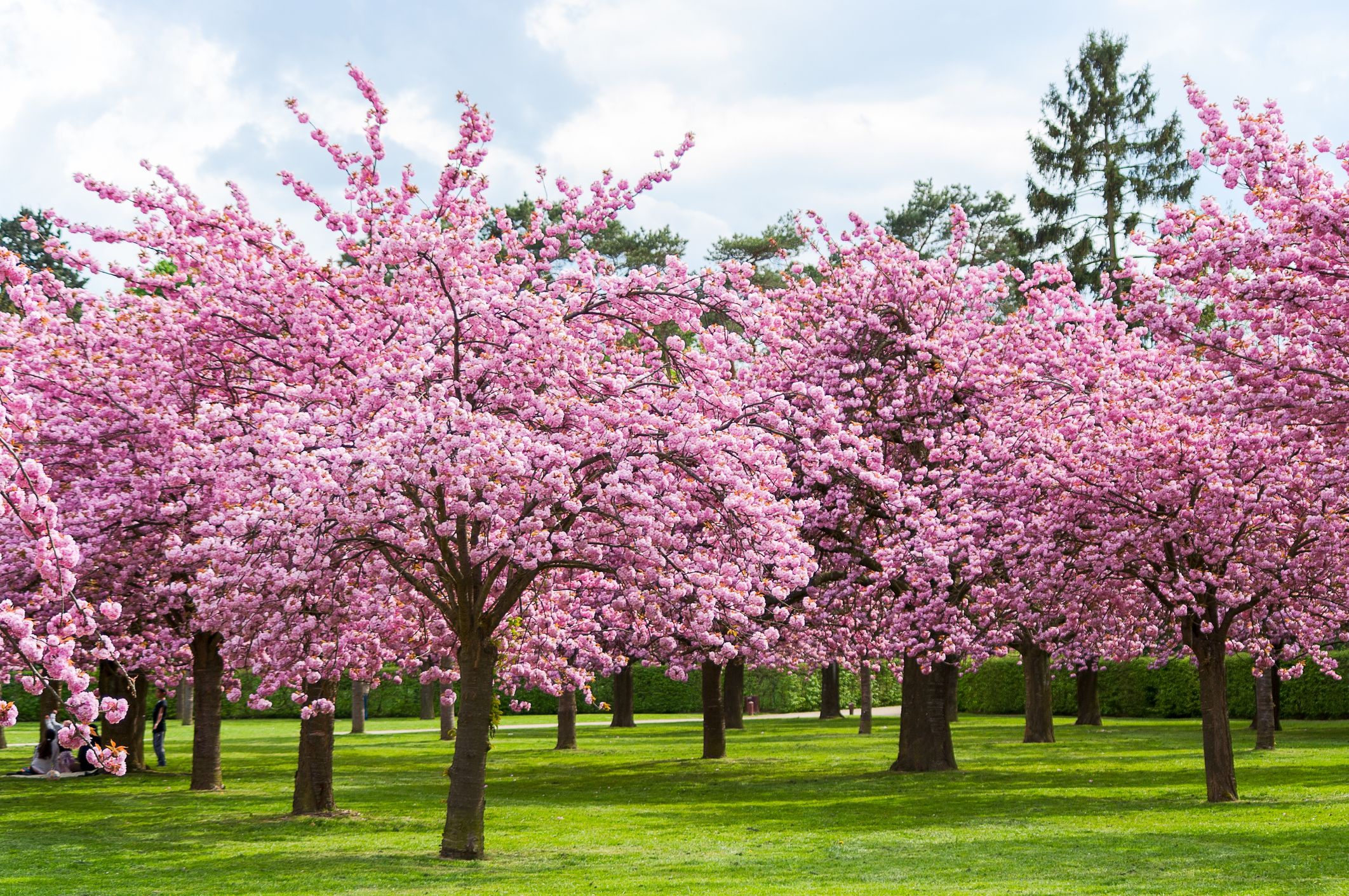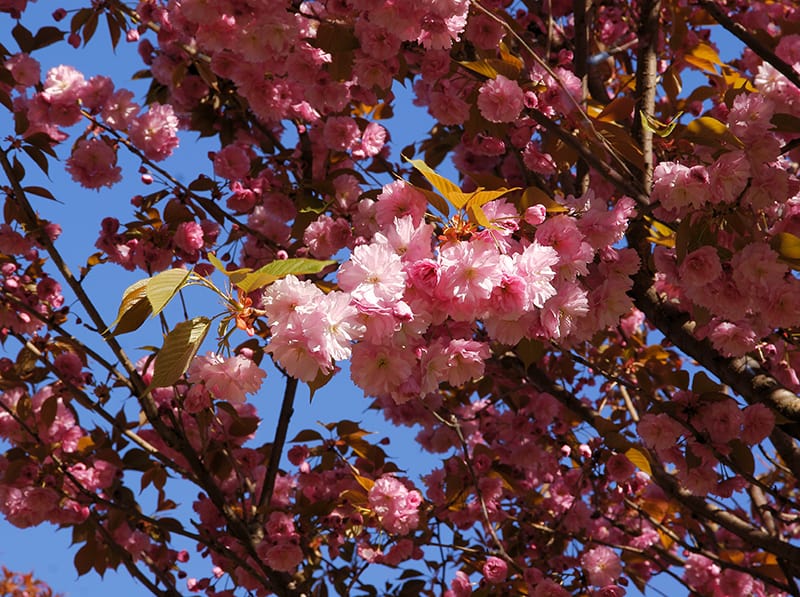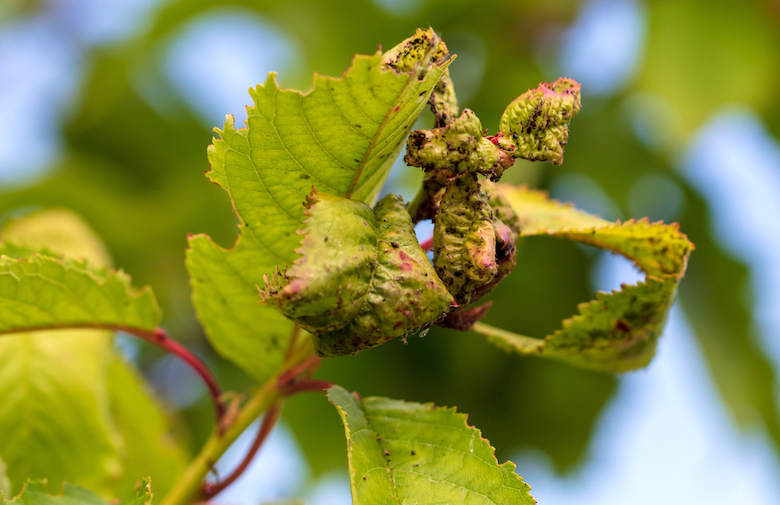Why Choose a Cherry Blossom Tree for Your Landscape?
Cherry blossom trees are a popular choice for gardeners and landscapers due to their stunning beauty and relatively low maintenance requirements. These trees are known for their vibrant pink or white flowers that bloom in the spring, creating a breathtaking display of color and fragrance. With over 600 varieties to choose from, there’s a cherry blossom tree to suit every climate, soil type, and available space.
One of the main benefits of having a cherry blossom tree in your garden is its ability to add a touch of elegance and sophistication to your outdoor space. These trees are relatively small in size, making them perfect for smaller gardens or landscapes. They also require minimal pruning and care, making them a great choice for busy gardeners.
In addition to their aesthetic appeal, cherry blossom trees also provide a range of benefits for the environment. They are a natural source of food for pollinators, such as bees and butterflies, and their flowers are a rich source of nectar. They also provide shade and shelter for wildlife, making them a great choice for gardeners who want to create a wildlife-friendly garden.
If you’re considering buying a cherry blossom tree for your garden, there are a few things to keep in mind. Look for a tree that is well-suited to your climate and soil type, and choose a variety that is disease-resistant and low-maintenance. With proper care and attention, a cherry blossom tree can provide years of beauty and enjoyment for you and your family.
Whether you’re a seasoned gardener or just starting out, a cherry blossom tree is a great choice for anyone looking to add a touch of beauty and elegance to their outdoor space. So why not consider buying a cherry blossom tree today and start enjoying the many benefits it has to offer?
How to Select the Right Cherry Blossom Tree for Your Climate and Space
When it comes to buying a cherry blossom tree, selecting the right variety for your climate and space is crucial for its success. With over 600 varieties to choose from, it can be overwhelming to decide which one to choose. However, by considering a few key factors, you can narrow down your options and find the perfect tree for your garden.
First, consider your climate. Cherry blossom trees prefer well-drained soil and full sun to partial shade. If you live in a hot and dry climate, look for varieties that are drought-tolerant, such as the Kwanzan or Yoshino. If you live in a cooler and wetter climate, look for varieties that are resistant to disease, such as the Weeping Cherry.
Next, consider your available space. Cherry blossom trees can range in size from 10 to 30 feet tall, so make sure to choose a variety that will fit comfortably in your garden. If you have a small garden, consider a dwarf or compact variety, such as the ‘Pink Cloud‘ or ‘Snow Fountains’.
Some popular varieties of cherry blossom trees include:
- Kwanzan: A popular variety known for its stunning pink flowers and compact growth habit.
- Yoshino: A classic variety known for its beautiful white flowers and vase-shaped growth habit.
- Weeping Cherry: A unique variety known for its weeping branches and stunning pink flowers.
When buying a cherry blossom tree, make sure to choose a reputable nursery or online retailer that specializes in trees. This will ensure that you get a healthy tree that is well-suited to your climate and space.
By considering your climate and space, and choosing the right variety of cherry blossom tree, you can enjoy the beauty of these stunning trees for years to come.
What to Look for When Buying a Cherry Blossom Tree from a Nursery or Online Retailer
When buying a cherry blossom tree, it’s essential to choose a healthy tree that will thrive in your garden. Whether you’re purchasing from a nursery or online retailer, there are several things to look for to ensure you get a high-quality tree.
First, consider the tree’s size. Cherry blossom trees can range in size from 1 to 10 feet tall, so make sure to choose a tree that is the right size for your garden. If you’re buying online, check the tree’s height and spread to ensure it will fit in your garden.
Next, inspect the tree’s root system. A healthy cherry blossom tree should have a well-developed root system that is free of damage or disease. Look for trees with a robust root system that is wrapped in burlap or a soil ball.
Also, check the tree for signs of disease or pests. Look for any visible signs of damage, such as cracks in the trunk or branches, or any signs of pests, such as aphids or scale.
When buying online, make sure to choose a reputable retailer that specializes in trees. Some popular online retailers include The Tree Center and Nature Hills. These retailers offer a wide selection of cherry blossom trees, and their trees are carefully packaged and shipped to ensure they arrive healthy and thriving.
When purchasing from a nursery, make sure to inspect the tree in person. Look for any signs of damage or disease, and ask the nursery staff about the tree’s history and care requirements.
By choosing a healthy cherry blossom tree from a reputable retailer, you can ensure that your tree will thrive in your garden for years to come. Whether you’re buying online or in person, make sure to do your research and choose a tree that is well-suited to your climate and space.
Some things to keep in mind when buying a cherry blossom tree include:
- Tree size: Make sure to choose a tree that is the right size for your garden.
- Root system: Look for trees with a well-developed root system that is free of damage or disease.
- Disease and pests: Inspect the tree for any visible signs of damage or pests.
- Reputable retailer: Choose a reputable retailer that specializes in trees.
By following these tips, you can find the perfect cherry blossom tree for your garden and enjoy its beauty for years to come.
Planting and Caring for Your New Cherry Blossom Tree
Once you’ve purchased your cherry blossom tree, it’s time to plant and care for it. With proper care, your tree will thrive and provide beautiful blooms for years to come.
Before planting, make sure to choose a location with full sun to partial shade and well-drained soil. Cherry blossom trees prefer slightly acidic soil with a pH between 6.0 and 6.5.
To plant your tree, follow these steps:
- Dig a hole that is twice as wide and just as deep as the tree’s root ball.
- Gently remove the tree from its container or burlap, taking care not to damage the roots.
- Place the tree in the hole, making sure the root flare (where the trunk flares out at the base of the tree) is level with the soil surface.
- Fill the hole with soil, tamping it down gently as you go to remove any air pockets.
- Water the tree thoroughly, making sure the soil is moist but not waterlogged.
After planting, make sure to water your tree regularly, especially during its first year. Cherry blossom trees prefer about 1 inch of water per week, either from rain or irrigation.
In addition to watering, fertilize your tree annually with a balanced fertilizer (10-10-10). This will provide essential nutrients for healthy growth and blooming.
Pruning is also an important part of caring for your cherry blossom tree. Prune your tree in late winter or early spring, removing any dead or damaged branches. This will help maintain the tree’s shape and promote healthy growth.
Some additional tips to keep in mind when caring for your cherry blossom tree include:
- Mulching: Mulch around the base of the tree to retain moisture and suppress weeds.
- Pest control: Keep an eye out for pests like aphids and scale, and treat promptly if necessary.
- Disease prevention: Regularly inspect your tree for signs of disease like powdery mildew or black knot, and treat promptly if necessary.
By following these care tips, you’ll be able to enjoy the beauty of your cherry blossom tree for years to come.
Common Mistakes to Avoid When Growing a Cherry Blossom Tree
While cherry blossom trees are relatively low maintenance, there are some common mistakes to avoid when growing them. By being aware of these mistakes, you can ensure that your tree thrives and provides beautiful blooms for years to come.
One of the most common mistakes to avoid is over-watering. Cherry blossom trees prefer well-drained soil and can be susceptible to root rot if the soil is too wet. Make sure to water your tree regularly, but avoid over-watering, especially during the winter months when the tree is dormant.
Another mistake to avoid is under-pruning. Cherry blossom trees require regular pruning to maintain their shape and promote healthy growth. Prune your tree in late winter or early spring, removing any dead or damaged branches. This will help maintain the tree’s shape and promote healthy growth.
Neglecting soil pH is also a common mistake to avoid. Cherry blossom trees prefer slightly acidic soil with a pH between 6.0 and 6.5. If your soil is too alkaline, it can affect the tree’s ability to absorb nutrients. Test your soil regularly and adjust the pH as needed.
Not providing enough sunlight is another mistake to avoid. Cherry blossom trees prefer full sun to partial shade, so make sure to plant your tree in a location that receives plenty of sunlight.
Finally, not protecting your tree from pests and diseases is a mistake to avoid. Cherry blossom trees can be susceptible to pests like aphids and scale, as well as diseases like powdery mildew and black knot. Regularly inspect your tree for signs of pests or diseases and take action promptly if necessary.
Some additional tips to keep in mind when growing a cherry blossom tree include:
- Mulching: Mulch around the base of the tree to retain moisture and suppress weeds.
- Fertilizing: Fertilize your tree annually with a balanced fertilizer (10-10-10) to promote healthy growth.
- Monitoring: Regularly monitor your tree’s health and take action promptly if you notice any signs of pests or diseases.
By avoiding these common mistakes, you can ensure that your cherry blossom tree thrives and provides beautiful blooms for years to come.
How to Prune and Train Your Cherry Blossom Tree for Optimal Bloom
Pruning and training your cherry blossom tree is essential for promoting healthy growth and optimal blooming. By following these tips, you can help your tree reach its full potential and enjoy beautiful blooms for years to come.
Pruning is an important part of cherry blossom tree care. It helps to maintain the tree’s shape, promote healthy growth, and encourage blooming. Prune your tree in late winter or early spring, removing any dead or damaged branches. This will help to prevent disease and encourage new growth.
When pruning, make sure to use the right tools and techniques. Use sharp, clean pruning shears to make clean cuts, and avoid tearing the bark. Remove any branches that are crossing or rubbing against each other, as well as any branches that are growing inwards towards the center of the tree.
In addition to pruning, training your cherry blossom tree is also important. Training involves shaping the tree to maintain its natural shape and promote healthy growth. Use a combination of pruning and staking to train your tree, and avoid over-training, which can cause stress and damage to the tree.
Some additional tips to keep in mind when pruning and training your cherry blossom tree include:
- Make clean cuts: Use sharp, clean pruning shears to make clean cuts, and avoid tearing the bark.
- Remove dead or damaged branches: Remove any branches that are dead or damaged, as well as any branches that are crossing or rubbing against each other.
- Avoid over-training: Avoid over-training your tree, which can cause stress and damage to the tree.
- Use a combination of pruning and staking: Use a combination of pruning and staking to train your tree, and avoid over-training.
By following these tips, you can help your cherry blossom tree reach its full potential and enjoy beautiful blooms for years to come.
Some popular pruning techniques for cherry blossom trees include:
- Central leader pruning: This involves pruning the tree to maintain a central leader, which is the main trunk of the tree.
- Open center pruning: This involves pruning the tree to create an open center, which allows for good air circulation and sunlight penetration.
- Modified leader pruning: This involves pruning the tree to maintain a modified leader, which is a combination of a central leader and an open center.
By using these pruning techniques, you can help your cherry blossom tree maintain its natural shape and promote healthy growth.
Pest and Disease Management for Cherry Blossom Trees
Cherry blossom trees are generally hardy and resistant to pests and diseases, but they can still be affected by certain issues. Regular monitoring and maintenance can help prevent and treat these problems, ensuring the health and beauty of your tree.
Aphids are a common pest that can affect cherry blossom trees. These small, soft-bodied insects feed on the sap of the tree, causing curled or distorted leaves. To control aphids, use insecticidal soap or neem oil, and make sure to spray the undersides of the leaves where the aphids tend to congregate.
Scale is another pest that can affect cherry blossom trees. These small, armored insects feed on the sap of the tree, causing stunted growth and yellowing leaves. To control scale, use insecticidal soap or horticultural oil, and make sure to spray the entire tree, including the trunk and branches.
Powdery mildew is a common disease that can affect cherry blossom trees. This fungal disease causes a white, powdery coating to form on the leaves, and can lead to premature defoliation. To control powdery mildew, use a fungicide specifically designed for ornamental trees, and make sure to spray the entire tree, including the undersides of the leaves.
Black knot is a fungal disease that can affect cherry blossom trees. This disease causes black, knot-like growths to form on the branches, and can lead to dieback and reduced blooming. To control black knot, use a fungicide specifically designed for ornamental trees, and make sure to prune any infected branches to prevent the disease from spreading.
Some additional tips to keep in mind when managing pests and diseases on your cherry blossom tree include:
- Monitor your tree regularly: Regular monitoring can help you catch any pest or disease issues early, before they become serious problems.
- Use integrated pest management: Use a combination of cultural, biological, and chemical controls to manage pests and diseases on your tree.
- Keep your tree healthy: A healthy tree is better able to resist pests and diseases, so make sure to provide your tree with regular watering, fertilization, and pruning.
By following these tips, you can help keep your cherry blossom tree healthy and thriving, and enjoy its beauty for years to come.
Enjoying the Beauty of Your Cherry Blossom Tree for Years to Come
Now that you’ve purchased and planted your cherry blossom tree, it’s time to enjoy its beauty for years to come. With proper care and maintenance, your tree will provide stunning blooms and a beautiful display of color in the spring.
One of the best ways to enjoy your cherry blossom tree is to host a garden party or picnic during its blooming period. Invite friends and family to come and admire the beauty of your tree, and enjoy the warm sunshine and fresh air of the spring season.
Another way to enjoy your cherry blossom tree is to take photos of its stunning blooms. Use a camera or smartphone to capture the beauty of your tree, and share your photos with friends and family on social media.
In addition to hosting a garden party or taking photos, you can also enjoy your cherry blossom tree by simply sitting in its shade and admiring its beauty. Take a moment to relax and unwind in the peaceful surroundings of your garden, and enjoy the beauty of your tree.
Some additional tips to keep in mind when enjoying your cherry blossom tree include:
- Be patient: Cherry blossom trees take time to mature and bloom, so be patient and enjoy the process of watching your tree grow and develop.
- Take care of your tree: Regular maintenance and care are essential for keeping your cherry blossom tree healthy and thriving.
- Enjoy the journey: Don’t just focus on the end result – enjoy the journey of growing and caring for your cherry blossom tree.
By following these tips, you can enjoy the beauty of your cherry blossom tree for years to come, and make the most of its blooming period.
Some popular activities to enjoy during the blooming period of your cherry blossom tree include:
- Garden parties: Host a garden party or picnic during the blooming period of your cherry blossom tree, and invite friends and family to come and admire its beauty.
- Photography: Take photos of your cherry blossom tree’s stunning blooms, and share them with friends and family on social media.
- Relaxation: Simply sit in the shade of your cherry blossom tree and enjoy the peaceful surroundings of your garden.
By enjoying your cherry blossom tree, you can make the most of its blooming period and create lasting memories with friends and family.






